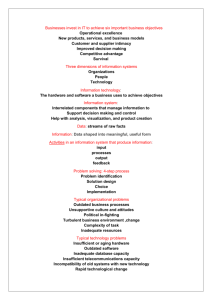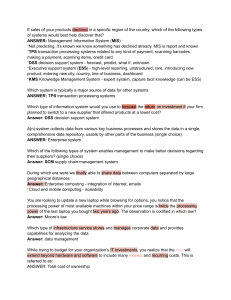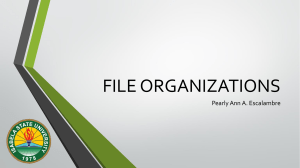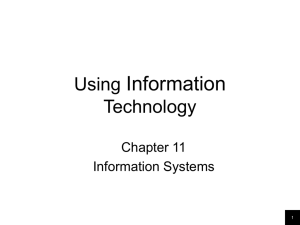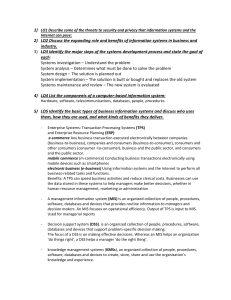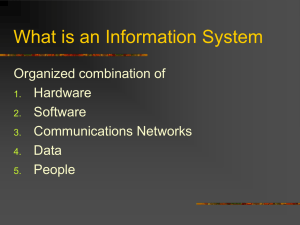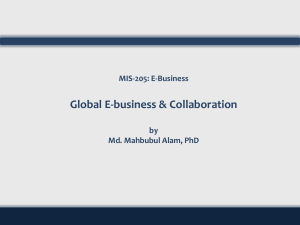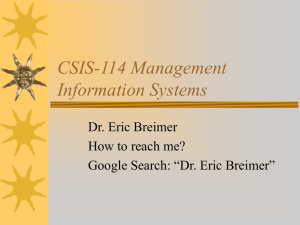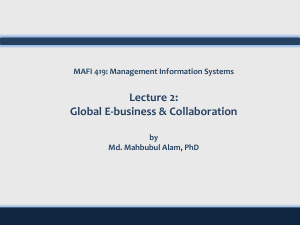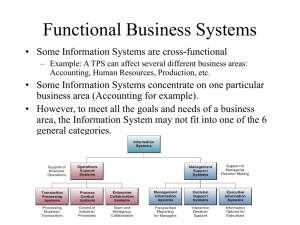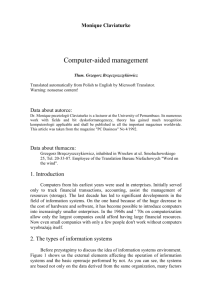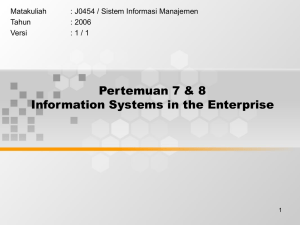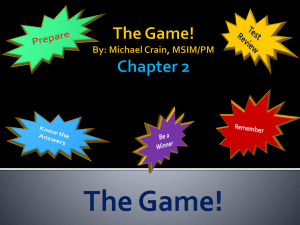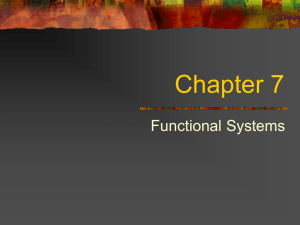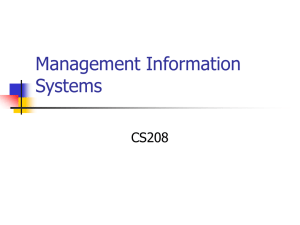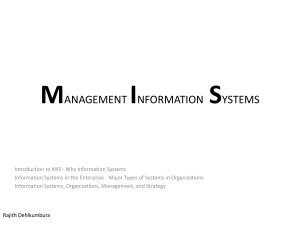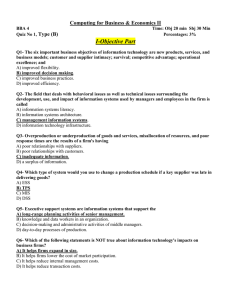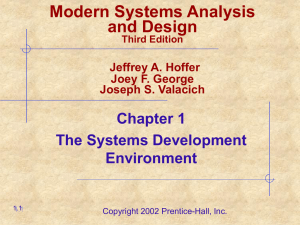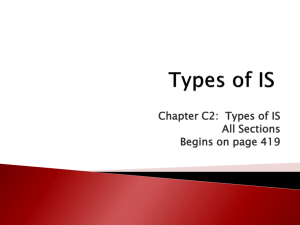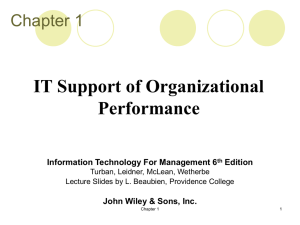chapter_2
advertisement
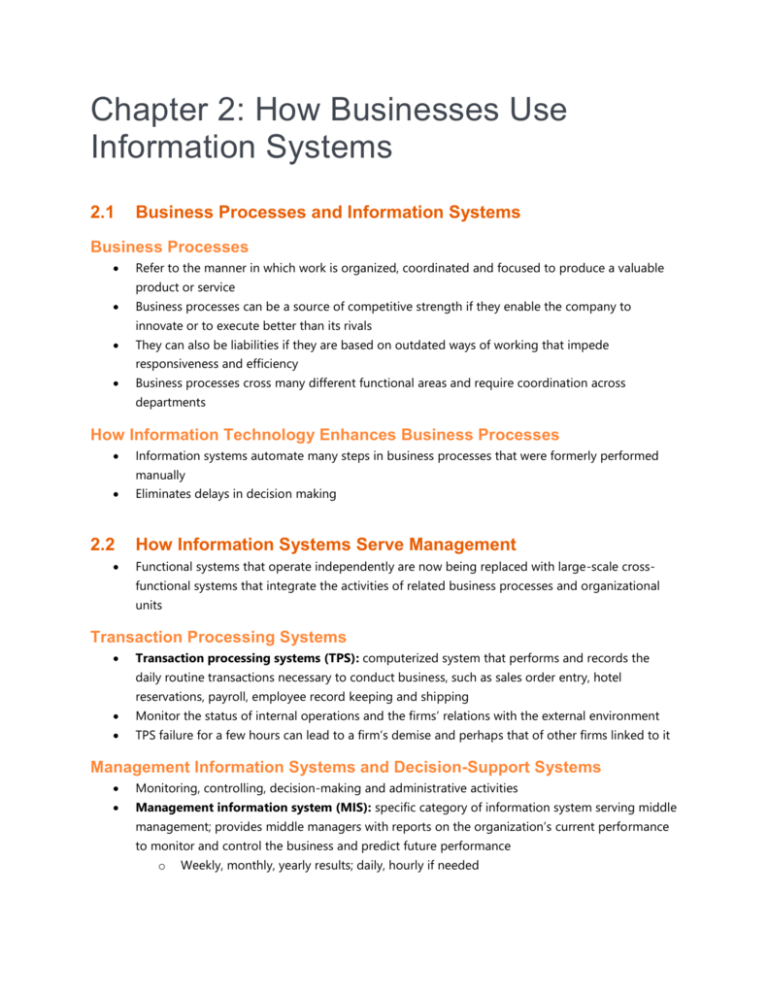
Chapter 2: How Businesses Use Information Systems 2.1 Business Processes and Information Systems Business Processes Refer to the manner in which work is organized, coordinated and focused to produce a valuable product or service Business processes can be a source of competitive strength if they enable the company to innovate or to execute better than its rivals They can also be liabilities if they are based on outdated ways of working that impede responsiveness and efficiency Business processes cross many different functional areas and require coordination across departments How Information Technology Enhances Business Processes Information systems automate many steps in business processes that were formerly performed manually 2.2 Eliminates delays in decision making How Information Systems Serve Management Functional systems that operate independently are now being replaced with large-scale crossfunctional systems that integrate the activities of related business processes and organizational units Transaction Processing Systems Transaction processing systems (TPS): computerized system that performs and records the daily routine transactions necessary to conduct business, such as sales order entry, hotel reservations, payroll, employee record keeping and shipping Monitor the status of internal operations and the firms’ relations with the external environment TPS failure for a few hours can lead to a firm’s demise and perhaps that of other firms linked to it Management Information Systems and Decision-Support Systems Monitoring, controlling, decision-making and administrative activities Management information system (MIS): specific category of information system serving middle management; provides middle managers with reports on the organization’s current performance to monitor and control the business and predict future performance o Weekly, monthly, yearly results; daily, hourly if needed Decision-support systems (DSS): information systems at the organization’s management level that combine data and sophisticated analytical models or data analysis tools to support semistructured and unstructured decision-making o Focus on unique and rapidly changing problems, solution may not be fully predefined in advance DSS use internal information from TPS and MIS & information from external sources, such as current stock prices or product prices of competitors DSS = business intelligence systems Executive Support Systems for Senior Management Senior managers need systems that address strategic issues and long-term trends, both in the firm and the external environment Executive support systems (ESS): information systems that address nonroutine decisions requiring judgment, evaluation and insight because there is no agreed-on procedure for arriving at a solution ESS incorporate data about external events, such as new tax laws or competitors, but also draw summarized info from MIS and DSS Display data of greatest importance to senior managers Digital dashboards are becoming an increasingly popular feature of ESS 2.3 Systems that Span the Enterprise Enterprise Applications Enterprise applications: systems that span functional areas, focused on executing business procedures across the business firm, and include all levels of management Help businesses become more flexible and productive by coordinating business processes more closely and integrating groups of processes so they focus on efficient management of resources and customer service Enterprise Systems Enterprise systems: integrated enterprise-wide information systems that coordinate key internal processes of the firm o Helped collect fragmented data in hundreds of separate systems o Also known as enterprise resource planning (ERP) systems Supply Chain Management Systems Supply chain management (SCM) systems: information systems that automate the flow of information between a firm and its suppliers in order to optimize the planning, sourcing, manufacturing and delivery of products and services Interorganizational system manage information flow across organizational boundaries Customer Relationship Management Systems Customer relationship management (CRM) systems: information systems that track all the ways in which a company interacts with its customers and analyze these interactions to optimize revenue, profitability, customer satisfaction and customer retention Consolidate and integrate customer information from multiple communication channels Knowledge Management Systems Knowledge management systems (KMS): information systems that collect all relevant knowledge and experience in the firm and make it available wherever & whenever it is needed to improve business processes and management decisions Link the firm to external sources of knowledge Supports processes for acquiring, storing, distributing, and applying knowledge + processes for creating new knowledge and integrating it into the organization Intranets and Extranets Increase integration and expedite the flow of information within the firm & with customers and suppliers Collaboration and Communication Systems: “Interaction” Jobs in a Global Economy Vital management tools o Internet-based collaboration environments (IBM’s Lotus Sametime) o E-mail and instant messaging (IM) o Cell phones and Smartphones o Social networking o Wikis o Virtual worlds E-Business, E-Commerce and E-Government E-business: use of digital technology and the Internet to execute the major business processes in the enterprise E-commerce: buying and selling of goods and services over the Internet E-government: application of the Internet and networking technologies to digitally enable government and public sector agencies’ relationships with citizens, businesses, and other arms of government 2.4 The Information Systems Function in Business IT department is formally responsible for maintain the hardware, software, data storage, and networks that comprise the firm’s IT infrastructure The Information Systems Department Programmers are highly trained technical specialists who write the software instructions for computers Systems analysts constitute the principal liaisons between the IS groups and the rest of the organization IS managers are leaders of teams of programmers and analysts, project managers, etc. Chief Information Officer (CIO) oversees the use of IT in the firm Chief Security Officer (CSO) is in charge of the IS security for the firm and is responsible for enforcing the firm’s information security policy Chief Privacy Officer (CPO) is responsible for ensuring that the company complies with existing data privacy laws Chief Knowledge Officer (CKO) is responsible for the firm’s knowledge management program Organizing the Information Systems Function Decentralized each functional area has its own IS department that reports to a senior manager or CIO Separate department similar to a functional department Divisional IS department IT governance: strategies and policies for using IT within an organization, specifying the rights and accountabilities to ensure that information technology supports the organization’s strategies and objectives
